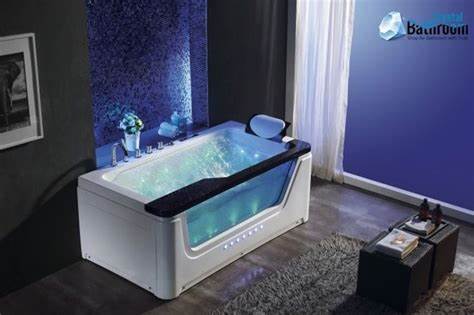Whirlpool baths are also known as spa baths and, incorrectly, as Jacuzzis. Jacuzzi is the name of a specific brand of whirlpool bath in the same way that Hoover is the name of a specific brand of vacuum cleaner.
They are baths which use jets to create a swirling motion in the water, similar to that of a whirlpool.
This means that, in addition to the benefits of a standard bath, they also provide a very gentle massage. Because whirlpool baths are so strongly associated with the health and wellness industry (and, in particular spas), there is some degree of perception that their primary use is for relaxation and stress relief.
This image may well be influenced by the fact that TV programmes and films routinely show them in this context. In reality however, the element of massage has very compelling medical benefits for the body as well as the mind, which is why whirlpool baths are also found in many gyms and prescribed by sports trainers and those who manage the fitness of elite sports people. At this time, there has been very little formal research undertaken into the benefits of whirlpool baths in and of themselves.
The Journal of Physical Therapy Science (a U.S.-based publication) did, however, publish an article titled “The Effects of a Warm Whirlpool Bath on Pain and Stiffness of Patients with Chronic Stroke Induced Knee Osteoarthritis”, which concluded that patients who received treatment in a whirlpool bath showed that “the whirlpool treatment was more effective at reducing stiffness” and concluded that “Immersion of the lower extremities in a whirlpool bath was beneficial for patients with chronic stroke-induced knee osteoarthritis.”.
This study is, of course, specific to one particular condition, but does help to provide validation for the use of whirlpool baths in sports and as a way to provide gentle treatment for joint- and/or muscle-related conditions in general. Ultimately whirlpool baths provide a combination of heat and massage, both of which have recognized health benefits. The fact that heat improves muscle flexibility and can help to reduce muscular pain has been known anecdotally for decades if not more.
Back in the early 1970s, Bikram Choudhury created Bikram Yoga, which was specifically intended to be practiced in a hot room to release toxins from the body and to help with muscle flexibility.
Since then, various other forms of “hot yoga” have been developed for much the same reason. Athletes with mild, highly localized muscle injuries automatically reach for muscle spray or muscle rub, which produces immediate heat right where it hurts.
Muscle injuries which relate to a larger area can be treated with heated pads or the old favourite of the hot water bottle. Whirlpool baths can literally provide heat to the whole body at once.
Over recent years, scientists have started to take an interest in determining whether the anecdotal experience of yoga practitioners, athletes and the medical staff who support them, can actually be supported with scientific evidence.
Back in 2013, the Medical Science Monitor (also a U.S.-based publication), published a study on the effect of heat on muscular flexibility.
The study found that “Heat is beneficial in increasing muscle and ligament flexibility and may help reduce athletic injuries”. Of course, any bath can be filled with hot water and heat can be provided in a variety of other ways.
The defining feature of a whirlpool bath is the whirlpool element and the light massage it provides. Just like the use of heat, the use of massage has been a feature of sports training for many years now.
Sport massage therapists help elite sports people to deal with the rigours of training and to promote recovery from muscle strains and other forms of minor injury. General massage therapists, provide all-around mental and physical relaxation, while gently stimulating the body’s systems.
As with heat, over recent years scientists have been starting to take an interest in whether the perceived health benefits of general massage do have any scientific basis.
Hence there have been quite a number of studies into the area, although many of these studies have looked its effect on mental health rather than on physical health.
There was, however, a 2008 study into the use of massage as a treatment for lower back pain, which found that it might be beneficial and recommended further study.
This was followed by further research in 2011, which looked at 2 different types of massage and their effects on lower back pain, as compared to no treatment.
The study concluded that “Massage therapy may be effective for treatment of chronic back pain, with benefits lasting at least 6 months.”. In addition to benefitting muscles and relieving muscular pain, the key effect of massage is to stimulate the body gently. This causes the body’s systems to work more quickly.
In particular it improves blood flow and helps to increase the speed at which toxins are expelled from the body.
These include toxins such as lactic acid, the source of post-exercise muscle cramps. In short therefore, whirlpool baths combine the benefits of both gentle heat and gentle massage.
They are renowned for their stress-relieving qualities, which can be as useful to sportspeople as to the less active. They are also useful for keeping the body in good shape.
As well as promoting muscle flexibility and healing after strain or injury, they also improve circulation and help to cleanse the body thoroughly by promoting the elimination of toxins.
https://www.ncbi.nlm.nih.gov/pmc/articles/PMC3820387/ https://www.ncbi.nlm.nih.gov/pmc/articles/PMC3747018/ https://www.ncbi.nlm.nih.gov/pubmed/18843627 https://www.ncbi.nlm.nih.gov/pubmed/21727288





























